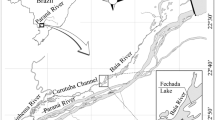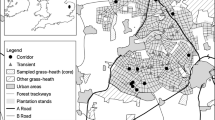Abstract
Micro-arthropods in moss patches have been used as a model system to investigate the effects of habitat destruction and fragmentation on population viability and ecosystem functioning. Previous assessments of the sensitivity to fragmentation and the effectiveness of mitigating landscape structures have to some extent been contradictory, one possible reason being a lack of knowledge of the realised dispersal distances of the species involved. We investigated the dispersal capabilities of oribatid mites (Acari: Oribatida) and springtails (Collembola) in an experimentally fragmented system consisting of bryophytes on a bare rock surface. We used defaunated patches that were recolonized from populated patches nearby as well as from a mainland surrounding the experimental arena, during 10 weeks in summer. We measured within-mainland, mainland-to-island, and island-to-island dispersal, and found that: (1) Oribatid mites were severely dispersal limited within the time frame of the experiment, even at isolation distances of only 5 cm; (2) springtails did not show any dispersal limitation over distances as far as 300 cm; (3) despite the observed dispersal limitation, the mainland had a relatively large influence on microarthropod occurrence, even at 300 cm distance; and (4) the dispersal rates were high enough for both species sorting and—in the case of collembolans—mass effects processes to occur. Our results indicate that fragmentation can strongly influence species occurrence and abundance in natural systems that are limited by dispersal. They also show that the presence of a distant mainland can override the influence of nearby habitat patches on local diversity and abundance.




Similar content being viewed by others
References
Anderson MJ (2001) Permutation tests for univariate or multivariate analysis of variance and regression. Can J Fish Aquat Sci 58:626–639
Andrén H (1994) Effects of habitat fragmentation on birds and mammals in landscapes with different proportions of suitable habitat: a review. Oikos 71:355–366
Bengtsson J (2010) Applied (meta)community ecology: diversity and ecosystem services at the intersection of local and regional processes. In: Verhoef HA and Morin PJ (eds) Community ecology. Oxford University Press, USA, pp 115–130
Coulson SJ, Hodkinson ID, Wooley C, Webb NR, Block W, Worland MR, Bale JS, Strathdee AT (1996) Effects of experimental temperature elevation on high-arctic soil microarthropod populations. Polar Biol 16:147–153
Cousins SAO, Ohlson H, Eriksson O (2007) Effects of historical and present fragmentation on plant species diversity in semi-natural grasslands in Swedish rural landscapes. Landsc Ecol 22:723–730
Dunger W, Schulz HJ, Zimdars B (2002) Colonization behaviour of Collembola under different conditions of dispersal. Pedobiologia 46:316–327
Edwards CA (1991) The assessment of populations of soil-inhabiting invertebrates. Agric Ecosyst Environ 34:145–176
Fahrig L (2003) Effects of habitat fragmentation on biodiversity. Annu Rev Ecol Evol Syst 34:487–515
Fazey I, Fischer J, Lindenmayer DB (2005) What do conservation biologists publish? Biol Conserv 124:63–73
Fletcher J, Ries L, Battin J, Chalfoun AD (2007) The role of habitat area and edge in fragmented landscapes: definitively distinct or inevitably intertwined? Can J Zool 85:1017–1030
Franklin AB, Noon BR, George TL (2002) What is habitat fragmentation? Stud Avian Biol 25:20–29
Gilbert F, Gonzalez A, Evans-Freke I (1998) Corridors maintain species richness in the fragmented landscapes of a microecosystem. Proc R Soc Lond B 265:577
Gilyarov MS, Krivolutsky DA (1975) A key to soil-inhabiting mites. Sarcoptiformes. Izdatel’stvo Nauka, Moscow
Gonzalez A (2000) Community relaxation in fragmented landscapes: the relation between species richness, area and age. Ecol Lett 3:441–448
Gonzalez A (2005) Local and regional community dynamics in fragmented landscapes: insights from a bryophyte-based microcosm. In: Holyoak M, Leibold MA, Holt R (eds) Metacommunities: spatial dynamics and ecological communities. Chicago University Press, Chicago, pp 146–169
Gonzalez A, Chaneton EJ (2002) Heterotroph species extinction, abundance and biomass dynamics in an experimentally fragmented microecosystem. J Anim Ecol 71:594–602
Gonzalez A, Lawton JH, Gilbert FS, Blackburn TM, Evans-Freke I (1998) Metapopulation dynamics, abundance, and distribution in a microecosystem. Science 281:2045
Gonzalez A, Mouquet N, Loreau M (2009) Biodiversity as spatial insurance: the effects of habitat fragmentation and dispersal on ecosystem functioning. In: Naeem S, Bunker DE, Hector A (eds) Biodiversity, ecosystem functioning, and human wellbeing: an ecological and economic perspective. Oxford University Press, USA, pp 134–146
Grear JS, Schmitz OJ (2005) Effects of grouping behavior and predators on the spatial distribution of a forest floor arthropod. Ecology 86:960–971
Helm A, Hanski I, Pärtel M (2006) Slow response of plant species richness to habitat loss and fragmentation. Ecol Lett 9:72–77
Hodkinson ID, Coulson SJ, Webb NR, Block W (1996) Can high Arctic soil microarthropods survive elevated summer temperatures? Funct Ecol 10:314–321
Holyoak M, Leibold MA, Holt RD (2005) Metacommunities: spatial dynamics and ecological communities. University of Chicago Press, Chicago
Hoyle M (2004) Causes of the species-area relationship by trophic level in a field-based microecosystem. Proc R Soc Lond B 271:1159–1164
Hoyle M, Gilbert F (2004) Species richness of moss landscapes unaffected by short-term fragmentation. Oikos 105:359–367
Hoyle M, Harborne AR (2005) Mixed effects of habitat fragmentation on species richness and community structure in a microarthropod microecosystem. Ecol Entomol 30:684–691
Hutson BR (1980) Colonization of industrial reclamation sites by acari, collembola and other invertebrates. J Appl Ecol 17:255–275
Jacobson B, Peres-Neto PR (2010) Quantifying and disentangling dispersal in metacommunities: how close have we come? How far is there to go? Landsc Ecol 25:495–507
Jonason D, Andersson GKS, Öckinger E, Rundlöf M, Smith HG, Bengtsson J (2011) Assessing the effect of time since transition to organic farming on plants and butterflies. J Appl Ecol 48:543–550
Jost L (2007) Partitioning diversity into independent alpha and beta components. Ecology 88:2427–2439
Leibold MA, Holyoak M, Mouquet N, Amarasekare P, Chase JM, Hoopes MF, Holt RD, Shurin JB, Law R, Tilman D, Loreau M, Gonzalez A (2004) The metacommunity concept: a framework for multi-scale community ecology. Ecol Lett 7:601–613
Lindberg N, Bengtsson J (2006) Recovery of forest soil fauna diversity and composition after repeated summer droughts. Oikos 114:494–506
Luxton M (1981) Studies on the oribatid mites of a Danish beech wood soil. Pedobiologia 21:312–340
Marshall VG (1972) Comparison of two methods of estimating efficiency of funnel extractors for soil microarthropods. Soil Biol Biochem 4:417–426
Mouillot D (2007) Niche-assembly vs. dispersal-assembly rules in coastal fish metacommunities: implications for management of biodiversity in brackish lagoons. J Appl Ecol 44:760–767
Ojala R, Huhta V (2001) Dispersal of microarthropods in forest soil. Pedobiologia 45:443–450
Oksanen J, Blanchet FG, Kindt R, Legendre P, O’Hara RB, Simpson GL, Solymos P, Stevens MHH, Wagner H (2010) Vegan: community ecology package. R package version 1.17-3. http://CRAN.R-project.org/package=vegan
Pandit SN, Kolasa J, Cottenie K (2009) Contrasts between habitat generalists and specialists: an empirical extension to the basic metacommunity framework. Ecology 90:2253–2262
Saunders DA, Hobbs RJ, Margules CR (1991) Biological consequences of ecosystem fragmentation: a review. Conserv Biol 5:18–32
Siepen H (1994) Life-history tactics of soil microarthropods. Biol Fertil Soils 18:263–278
Srivastava DS, Kolasa J, Bengtsson J, Gonzalez A, Lawler SP, Miller TE, Munguia P, Romanuk T, Schneider DC, Trzcinski MK (2004) Are natural microcosms useful model systems for ecology? TREE 19:379–384
Starzomski BM, Srivastava DS (2007) Landscape geometry determines community response to disturbance. Oikos 116:690–699
R Development Core Team (2010) R: A language and environment for statistical computing. R Foundation for Statistical Computing, Vienna, Austria. ISBN 3-900051-07-0. http://www.R-project.org
Tilman D, May RM, Lehman CL, Nowak MA (1994) Habitat destruction and the extinction debt. Nature 371:65–66
Venables WN, Ripley BD (2002) Modern applied statistics with S. Springer, New York
Walter DE, Proctor HC (1999) Mites: ecology, evolution and behaviour. CABI Publishing, Wallingford
Wanner M, Dunger W (2002) Primary immigration and succession of soil organisms on reclaimed opencast coal mining areas in eastern Germany. Eur J Soil Biol 38:137–143
Wilcox BA, Murphy DD (1985) Conservation strategy—effects of fragmentation on extinction. Am Nat 125:879–887
Willmann C (1931) Moosmilben oder Oribatiden (Oribatei). In: Dahl F (ed) Die Tierwelt Deutschlands No. 22. Gustav Fischer, Jena, pp 79–200
Acknowledgments
We thank Niklas Lindberg for help with mite identification and for establishing the experimental site. Tomas Pärt and Bram Vanschoenwinkel had valuable comments on an earlier version of this paper. The work was funded by the Swedish Research Council with which the authors declare no conflict of interest. This experiment was conducted in accordance with Swedish law.
Author information
Authors and Affiliations
Corresponding author
Additional information
Communicated by Roland Brandl.
Rights and permissions
About this article
Cite this article
Åström, J., Bengtsson, J. Patch size matters more than dispersal distance in a mainland–island metacommunity. Oecologia 167, 747–757 (2011). https://doi.org/10.1007/s00442-011-2024-y
Received:
Accepted:
Published:
Issue Date:
DOI: https://doi.org/10.1007/s00442-011-2024-y




